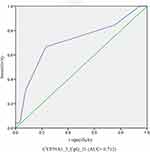Back to Journals » Pharmacogenomics and Personalized Medicine » Volume 16
The Association of Methylation Level in the CYP39A1 Gene with High Altitude Pulmonary Edema in the Chinese Population
Authors Wang P, Lu H, Rong H, Wang Y, Wang L , He X, Yuan D, He Y, Jin T
Received 28 November 2022
Accepted for publication 7 June 2023
Published 21 June 2023 Volume 2023:16 Pages 617—628
DOI https://doi.org/10.2147/PGPM.S397862
Checked for plagiarism Yes
Review by Single anonymous peer review
Peer reviewer comments 3
Editor who approved publication: Dr Martin H Bluth
Pingyi Wang,1– 3 Hongyan Lu,1– 3 Hao Rong,1– 3 Yuhe Wang,1– 4 Li Wang,1– 3 Xue He,1– 3 Dongya Yuan,1– 3 Yongjun He,1– 3 Tianbo Jin1– 3
1Key Laboratory of Molecular Mechanism and Intervention Research for Plateau Diseases of Tibet Autonomous Region, School of Medicine, Xizang Minzu University, Xianyang, Shaanxi, People’s Republic of China; 2Key Laboratory of High Altitude Hypoxia Environment and Life Health, School of Medicine, Xizang Minzu University, Xianyang, Shaanxi, People’s Republic of China; 3School of Basic Medical Sciences, Xizang Minzu University, Xianyang, Shaanxi, People’s Republic of China; 4Department of Clinical Laboratory, the Affiliated Hospital of Xizang Minzu University, Xianyang, Shaanxi, People’s Republic of China
Correspondence: Tianbo Jin; Yongjun He, Tel +86-18681940990 ; +86-18691008772, Email [email protected]; [email protected]
Background: High altitude pulmonary edema (HAPE) is still the most common fatal disease at high altitudes. DNA methylation proceeds with an important role in HAPE progression. This study was designed to investigate the association between CYP39A1 methylation and HAPE.
Methods: Peripheral blood samples were enrolled from 106 participants (53 HAPE patients and 53 healthy subjects) to study the association of CYP39A1 methylation with HAPE. DNA methylation site in the promoter region of CYP39A1 was detected by Sequenom MassARRAY EpiTYPER platform.
Results: Probability analysis showed that the methylation probabilities of CYP39A1_1_CpG_5 and CYP39A1_3_CpG_21 are significant differences between the cases and controls (p< 0.05). The methylation level analysis indicated that CYP39A1_1_CpG_2.3.4, CYP39A1_5_CpG_6.7, and CYP39A1_5_CpG_9.10 were higher methylation in HAPE compared to the controls (p< 0.05). CYP39A1_3_CpG_21 and CYP39A1_4_CpG_3 exhibited a lower methylation level in HAPE than that in the controls (p< 0.05). The association analysis given that CYP39A1_1_CpG_2.3.4 (OR 2.56, p= 0.035), CYP39A1_5_CpG_6.7 (OR 3.99, p= 0.003), CYP39A1_5_CpG_9.10 (OR 3.99, p= 0.003), CYP39A1_5_CpG_16.17.18 (OR 2.53, p= 0.033), and CYP39A1_5_CpG_20 (OR 3.05, p= 0.031) are associated with an increased risk of HAPE. Whereas CYP39A1_1_CpG_5 (OR 0.33, p= 0.016) and CYP39A1_3_CpG_21 (OR 0.18, p= 0.005) have a protective role in HAPE. Besides, age-stratification analysis showed that CYP39A1_1_CpG_5 (OR 0.16, p= 0.014) and CYP39A1_3_CpG_21 (OR 0.08, p= 0.023) had a protective impact on HAPE in people aged ≤ 32 years. CYP39A1_5_CpG_6.7 (OR 6.70, p= 0.008) and CYP39A1_5_CpG_9.10 (OR 6.70, p= 0.008) were related to an increased susceptibility to HAPE aged > 32 years. Moreover, the diagnostic value of CYP39A1_3_CpG_21 (AUC = 0.712, p< 0.001) was significantly better than other CpG sites.
Conclusion: The methylation level of CYP39A1 was associated with a risk of HAPE in the Chinese population, which provided new perspective for preventing and diagnosing of HAPE.
Keywords: HAPE, DNA methylation, CYP39A1, CpG, the Chinese population
Introduction
High altitude pulmonary edema (HAPE) is a kind of rapid noncardiogenic pulmonary edema, which usually occurs in people who visit to altitudes above 2500–3000 m within 2–4 days.1 The incidence of HAPE is high and the symptoms are severe.2 If not addressed in a timely manner, it can develop into a coma in a relatively short time and even lead to death.3 There is the absence of effective ways to evaluate the prevention and treatment of HAPE. It is assumed that the occurrence of HAPE is a complex process that involved in multi-factor and many genes.4 The happening and development of HAPE is related to observable individual and racial diversity, and it is affected by the environmental and genetic factors. However, the pathogenic mechanism of HAPE is not yet clear. It is a focus topic in high altitude medical research to study the pathogenesis of acute HAPE and explore the genetic markers that can predict high altitude pulmonary edema so as to prevent in advance and reduce the incidence. Previous studies reported that genetic polymorphisms in some genes such as IL6, ACYP2, RTEL1, and NR3C2 are significantly associated with the risk of HAPE.5–8 DNA methylation is one of the main regulatory mechanisms of epigenetics, which can regulate the expression of target genes without changing the DNA sequence by silencing promoters and altering the transcription of the regulatory genome.9 The methylation of the CpG site near the gene promoter is linked to the transcriptional activity and expression of the gene.10,11 An increasing study has shown that DNA methylation significantly contributes to the occurrence of lung diseases.12–15 These studies indicated that DNA methylation also plays a potential role in the development of HAPE.
Cytochrome P450 family 39 Subfamily A Member 1 (CYP39A1), a member of the cytochrome P450 superfamily of enzymes, mainly involves in the drug metabolism and biosynthesis of cholesterol. Besides, previous studies indicated that CYP39A1 contributes to the occurrence and development of numerous human diseases. Li et al showed that down regulation of CYP39A1 was related to hepatocellular carcinoma carcinogenesis, tumor differentiation, and poor overall survival in the Chinese population.16 Huang et al observed that hypermethylation of CYP39A1 correlated with an increase rate of relapsing in ovarian cancer among European ancestry individuals.17 In addition, it was found that CYP39A1 G204E mutation had a significantly increased risk of blindness, higher occurrence of exfoliation glaucoma, and severe glaucoma in the Japanese individuals.18 CYP39A1 rs7761731 polymorphism was linked to a higher incidence of leucopenia and infections or death during induction chemotherapy of head and neck cancer in European ancestry participants.19 Moreover, CYP39A1 exhibited significant underexpression in adenocarcinoma and squamous cell carcinoma compared to normal lung tissues, and differential expression of CYP39A1 might be due to hypermethylation of CYP39A1 gene in lung tumor cells.20 To sum up, we guess that CYP39A1 methylation may play an important role in lung-related diseases such as HAPE. The molecular mechanism of CYP39A1 methylation in HAPE is unclear. Whether the DNA methylation in the CYP39A1 gene can impact the occurrence of HAPE is needed to be explored.
Taken together, we speculated DNA methylation in the CYP39A1 gene has a possible role in the progression of HAPE. Thus, this study was conducted to investigate the association of DNA methylation in CYP39A1 with HAPE in the Chinese population. Our study will provide additional perspective of understanding the epigenetic modifications of CYP39A1 in HAPE pathophysiology.
Materials and Methods
Study Subjects
Before recruiting study subjects, we calculated the sample size using G.Power software (version 3.0), and followed by the conditions: Effect size = 0.50, α= 0.05, power (1-β)= 0.95, the calculated total sample size was 54. In this study, we recruited 106 (53 HAPE patients and 53 healthy volunteers) unrelated Chinese population from the Affiliated Hospital of Xizang Minzu University. All subjects with prior cardiovascular disease, acute altitude disease, and other lung diseases were excluded in this study before entering high-altitude area. The patients were sojourners, chronically living in low-altitude area, who had recently arrived at the high-altitude area (Tibet altitude: 4000–5000 m). After exposure to the high-altitude area within 7 days, they returned to the plain area and were first diagnosed with HAPE based on chest X-rays and standard diagnostic criteria.21 The diagnostic criteria of HAPE were as follows: (1) the clinical symptoms were cough, dyspnea at rest, hypoxemia, lung rale and cyanosis, and subnormal SaO2; (2) The clinical diagnosis was based on chest radiography, and the specific manifestations were dotted or flocculent infiltrating shadows in unilateral or bilateral lung fields with hilum as the center, which could form large pulmonary edema with diffuse distribution. Controls, chronically residing in low-altitude, had no HAPE or related diseases after exposure to the high-altitude within 7 days at the same time as the case. Their identity (sojourner), native place (low altitude area or high altitude area), age, gender, physical activities (carried out routine strenuous physical activities or not), and way of entering the plateau (hiking or not) were all matched with the cases. All participants agreed to the informed consent and interviewed using a self-administered questionnaire that included a complete medical history, demographic data, and physical condition. Besides, the clinical characteristics such as identity, native place, age, gender, and way of entering the plateau were obtained by a self-administered questionnaire. Our research was approved by the Ethics Committee of the Affiliated Hospital of Xizang Minzu University. All experiments were carried out in accordance with the protocol of Helsinki’s declaration.
DNA Isolation and Methylation Analyses
Genomic DNA was extracted from peripheral blood samples of all participants by the GoldMag-Mini Purification Kit (GoldMag Co. Ltd. Xi’an, China). PCR primers for PCR amplification were designed by Agena Bioscience EpiDesigner (http://www.epidesigner.com/), and are listed in Table S1. The genomic region of CpGs in CYP39A1 was chr6:46652805–46653452. The sequencing region for methylation was in the promoter region of CYP39A1. The prediction evaluation of each CpG site in different CYP39A1 gene fragments was shown in Figure S1. MassARRAY Epityper DNA platform and MALDI-TOF detection were performed to detect and analyze the methylation of CYP39A1.22
Statistical Analyses
The comparisons of age and gender between cases and controls were, respectively, detected by a Student’s t-test and Pearson’s X2 test. Besides, the Pearson’s X2 test was performed to compare the methylation probability between cases and controls. In probability analysis, when the methylation value is greater than or equal to 0.05, it is considered that methylation occurs at this site. When the methylation value is lesser than 0.05, no methylation occurs at this site. The differences of methylation levels were compared by non-parametric Wilcoxon rank-sum test since they were not normally distributed between the case and control group. To evaluate the effect of methylation level on case-control status, multivariable unconditional logistic regression was used to determine odds ratio (OR) and its 95% confidence interval (CI) for each individual CpG site, adjusted for age and gender. In logistic analysis, methylation levels were divided into two groups (high methylation and low methylation) using the median of the methylation value, based on the distribution for that site in the controls, with the low methylation group (methylation level < median value) as the reference. Model formula for logistic regression analysis was logit(p)=a+b1x1+.bnxn. Receiver operating characteristic (ROC) curve analysis, including calculation of the area under the ROC curve (AUC), was used to evaluate the ability of methylation at individual CpG sites to separate individuals with disease from controls. A p- value< 0.05 (two-sided) means statistical significance. All p values were corrected for multiple testing by the false discovery rate (FDR) method. All analyses were performed with SPSS statistics software (version 20.0).
Results
Study Population
Fifty-three patients with HAPE and 53 healthy subjects were enrolled in our study. The general characteristics of the participants are shown in Table 1. The mean age was 32.47 ± 10.18 years old in cases and 32.60 ± 10.50 years old in controls. There was no significant difference in age and gender between the cases and controls (p= 0.948, p= 1.000, respectively).
 |
Table 1 General Characteristics of Study Participants |
Methylation Levels of CYP39A1 in HAPE
A total of 43 sites in the promoter region of CYP39A1 were detected, 12 of which were missing, and 31 sites were finally analyzed in our study. The methylation degree of each CpG site in case and control groups was presented in Figure S2. Pearson′s X2 test was performed to compare methylation probability of CYP39A1 between the cases and controls. The number after the gene name represents the gene segment (we designed five pairs of methylation primers), the number after CpG represents the site, and the multiple numbers after CpG are due to the relatively close distance of these sites. Due to technical limitations, methylation levels of these sites were mixed for detection. As is presented in Table 2, the methylation probabilities of CYP39A1_1_CpG_5 and CYP39A1_3_CpG_21 are significant difference between the cases and controls (p= 0.015, p= 0.003; respectively). We calculated the average methylation value of each CpG site and methylation levels between cases and controls were further compared by non-parametric Wilcoxon rank-sum test. As shown in Table 3, the methylation levels of CYP39A1_1_CpG_2.3.4 (p= 0.013), CYP39A1_5_CpG_6.7 (p= 0.006), and CYP39A1_5_CpG_9.10 (p= 0.006) were higher in HAPE compared to the controls. CYP39A1_3_CpG_21 (p= 0.000) and CYP39A1_4_CpG_3 (p= 0.002) exhibited a lower methylation level in HAPE than that in the controls.
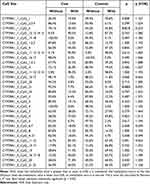 |
Table 2 Probability Analysis of Methylation of CYP39A1 in Case and Control |
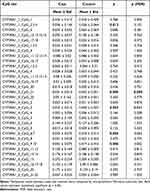 |
Table 3 Difference of Methylation Levels of CYP39A1 Between the Case and Control |
The Association Between CYP39A1 Methylation Sites and HAPE
We further investigated the correlations between CYP39A1 methylation sites and HAPE and the results are shown in Table 4. Our study indicated that CYP39A1_1_CpG_2.3.4 (OR 2.56, 95% CI = 1.07–6.13, p= 0.035), CYP39A1_5_CpG_6.7 (OR 3.99, 95% CI = 1.61–9.91, p= 0.003), CYP39A1_5_CpG_9.10 (OR 3.99, 95% CI = 1.61–9.91, p= 0.003), CYP39A1_5_CpG_16.17.18 (OR 2.53, 95% CI = 1.08–5.92, p= 0.033), and CYP39A1_5_CpG_20 (OR 3.05, 95% CI = 1.11–8.43, p= 0.031) are associated with an increased risk of HAPE. While CYP39A1_1_CpG_5 (OR 0.33, 95% CI = 0.13–0.81, p= 0.016) and CYP39A1_3_CpG_21 (OR 0.18, 95% CI = 0.05–0.59, p= 0.005) have a protective role in the risk of HAPE.
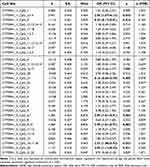 |
Table 4 Association of CYP39A1 Methylation Levels with HAPE by Multivariate Analysis |
The Association of CYP39A1 Methylation with HAPE Under Age-Stratification Analysis
We further studied the correlations between CYP39A1 methylation and HAPE stratified by age. As shown in Table 5, our study indicated that CYP39A1_1_CpG_5 (OR 0.16, 95% CI = 0.40–0.69, p= 0.014) and CYP39A1_3_CpG_21 (OR 0.08, 95% CI = 0.01–0.70, p= 0.023) had a protective impact on HAPE in people aged ≤32 years. Besides, CYP39A1_5_CpG_6.7 (OR 6.70, 95% CI = 1.63–27.58, p= 0.008) and CYP39A1_5_CpG_9.10 (OR 6.70, 95% CI = 1.63–27.58, p= 0.008) were related to an increased susceptibility to HAPE aged >32 years.
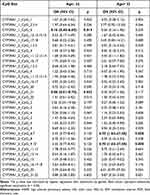 |
Table 5 The Correlation Between CYP39A1 Methylation and HAPE Risk Stratified by Age |
The Diagnostic Value of CYP39A1 DNA Methylation Sites for HAPE
ROC analysis was used to evaluate the diagnostic value of CYP39A1 methylation for HAPE. The value of AUC was computed to assess the ability of CYP39A1 methylation to diagnose HAPE. As presented in Table 6 and Figure 1, we found that the diagnostic value of CYP39A1_3_CpG_21 (AUC = 0.712, p< 0.001) was significantly better than other CpG sites (AUC < 0.700, p < 0.05), indicating that CYP39A1_3_CpG_21 may be used as a diagnostic indicator for HAPE compared to other CpG sites. Besides, we observed that the AUC of the combination of the significant CpG sites (CYP39A1_1_CpG_2.3.4+ CYP39A1_3_CpG_21+ CYP39A1_4_CpG_3+ CYP39A1_5_CpG_6.7+ CYP39A1_5_CpG_9.10) was 0.713 (p< 0.05) (Figure 2).
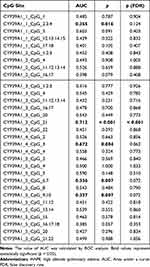 |
Table 6 Analysis of the Diagnostic Value of Each CpG Site in CYP39A1 for HAPE |
Discussion
In this study, we explored the associations of CYP39A1 methylation with HAPE in the Chinese population. Our results indicated that the DNA methylation in CYP39A1 has a probable role in the occurrence of HAPE. CYP39A1 methylation was related to the risk of HAPE. To the best of our knowledge, our study is the first time to detect the association between DNA methylation in the CYP39A1 gene and HAPE, which may provide a novel biomarker for the diagnosis of HAPE in the Chinese population.
Studies on high-altitude diseases have shown that some essential genes related to pharmacogenomics are involved in the occurrence of HAPE (https://www.pharmgkb.org/view/vips.jsp). CYP450 enzymes are comprised of a group of enzyme proteins encoded by gene superfamily, which are isozymes encoded by a group of structure and function related superfamily genes, and are important pharmacogenomics gene families. CYP39A1 is the important member of CYP450, which involves the drug metabolism and biosynthesis of cholesterol. Previous study suggested that hypoxia adaptation is a complex trait. In order to deal with hypoxia, the human body will also initiate some apparent regulatory mechanisms such as gene methylation except for activating and stabilizing transcriptional regulatory factors, which can lead to long-term changes in gene expression. The methylation level of CYP39A1 gene will be changed under unusual conditions (such as tumor, drug therapy, smoking, etc.), which will lead to abnormal expression of CYP39A1.23–25 The methylation of CYP39A1 may have a possible role in the development of HAPE. DNA methylation is the methylation modification of carbon atoms under the action of DNA methyltransferase. Cytosine phosphate guanine (CpG) site-specific DNA methylation changes occur in human and mammalian cells. Clustered CpG regions are called CpG islands, which are common in the promoter region of genes and are switches for regulating gene expression.26,27 Thus, we determined the association between methylation of the promoter region in the CYP39A1 gene and HAPE. We found that CYP39A1_1_CpG_2.3.4, CYP39A1_5_CpG_6.7, and CYP39A1_5_CpG_9.10 were higher methylation in HAPE compared to the controls. CYP39A1_3_CpG_21 and CYP39A1_4_CpG_3 exhibited a lower methylation level in HAPE than that in the controls. Levels of DNA methylation as a promoter-associated CpG island are generally negatively associated with gene expression. For example, Cui et al reported that CpG sites with higher methylation levels in esophageal squamous cell carcinoma tissues exhibited lower expression level of miR-203.28 Additionally, Zhou et al showed that CYP2S1 gene expression is negatively associated with DNA methylation in psoriasis.29 Therefore, we speculate that these high levels of CpG sites may influence the occurrence of HAPE by down regulating the CY939A1 gene expression, and further study is necessary to confirm this hypothesis.
The association analyses indicated that CYP39A1_1_CpG_2.3.4, CYP39A1_5_CpG_6.7, CYP39A1_5_CpG_9.10, CYP39A1_5_CpG_16.17.18, and CYP39A1_5_CpG_20 were linked to an increased risk of HAPE. While CYP39A1_1_CpG_5 and CYP39A1_3_CpG_21 have a protective role in the risk of HAPE. Our study suggests that the DNA methylation in CYP39A1 is related to HAPE.
It has been shown that certain CpG sites are highly associated with age.30,31 Some findings demonstrate that promoter-associated CpG islands have a tendency to increase methylation with age.32,33 Because the average age of the participants was 32 years in the current study, we stratified by 32 years. We observed that CYP39A1_1_CpG_5 and CYP39A1_3_CpG_21 had a protective impact on HAPE in people aged ≤32 years. In addition, high methylation of CYP39A1_5_CpG_6.7 and CYP39A1_5_CpG_9.10 were related to an increased susceptibility to HAPE at aged >32 years. Our data suggest that the association of CYP39A1_5_CpG_6.7 and CYP39A1_5_CpG_9.10 with HAPE may also be affected by age.
HAPE is a fatal disease brought about by acute exposure to high-altitude and hypoxia leading to fluid accumulation in the lungs. Early diagnosis for HAPE is of great importance for its prevention and treatment. DNA methylation can be utilized to detect and diagnose HAPE. We performed ROC analysis to evaluate the diagnostic value of CYP39A1 methylation for HAPE, and we found that CYP39A1_3_CpG_21 has a higher diagnostic value for HAPE compared to other CpG sites (AUC = 0.712). There is one paper assessing diagnostic value of CYP2S1 methylation in HAPE, and they showed that the AUC value of CYP2S1_3_CpG_11.12 was 0.672.22 The comparison suggests that CYP39A1 could be a candidate diagnostic biomarker for molecular targeting prevention and therapy for HAPE.
Our study had some limitations. First, there is no functional verification in the current research. We will test mRNA expression and functional experiment to further explore the potential role of the CYP39A1 methylation in HAPE. Second, the correlation between CpG methylation and gene expression has not been conducted, and the association will be determined in the next. Third, the role of CYP39A1 methylation in HAPE severity has not been explored, we will determine the association between CYP39A1 methylation and HAPE severity by collecting different severity of HAPE in future. Despite the above disadvantages, our findings firstly provided evidence that CYP39A1 DNA methylation was correlated with HAPE susceptibility, which may provide a novel biomarker for the prevention and diagnosis of HAPE.
Conclusions
Our present study indicated that CYP39A1 methylation was related to HAPE susceptibility. DNA methylation in the CYP39A1 gene has a potential role in the occurrence of HAPE.
Ethics Approval and Consent to Participate
All procedures performed in studies involving human participants were in accordance with the ethical standards of the Affiliated Hospital of Xizang Minzu University and the 1964 Helsinki declaration. Informed written consent was obtained from each participant before the research.
Acknowledgment
We thank all those participants in this study. We also thank the Affiliated Hospital of Xizang Minzu University for their helping with sample collections.
Funding
Our study was supported by Key R&D Program of Xizang (Tibet) Autonomous Region (XZ202101ZY0018G-TB J) and Science and Technology Major Project of Tibetan Autonomous Region of China (XZ202201ZD0001G03-TB J).
Disclosure
There were not any competing interests.
References
1. Hackett PH, Roach RC. High-altitude illness. N Engl J Med. 2001;345(2):107–114. doi:10.1056/NEJM200107123450206
2. Hultgren H. High altitude pulmonary edema: hemodynamic aspects. Int J Sports Med. 1997;18(1):20–25. doi:10.1055/s-2007-972589
3. Madden L, Sandström M, Lovell R, McNaughton L. Inducible heat shock protein 70 and its role in preconditioning and exercise. Amino Acids. 2008;34(4):511–516. doi:10.1007/s00726-007-0004-7
4. Simonson T, Yang Y, Huff C, et al. Genetic evidence for high-altitude adaptation in Tibet. Science. 2010;329(5987):72–75. doi:10.1126/science.1189406
5. He X, Wang L, Zhu L, Yuan D, He Y, Jin T. A case-control study of the genetic polymorphism of IL6 and HAPE risk in a Chinese han population. Clin Respir J. 2018;12(9):2419–2425. doi:10.1111/crj.12922
6. He Y, Zhang X, Li X, et al. Telomere length-related gene ACYP2 polymorphism is associated with the risk of HAPE in Chinese Han population. J Gene Med. 2016;18(9):244–249. doi:10.1002/jgm.2896
7. Rong H, He X, Zhu L, et al. Association between regulator of telomere elongation helicase1 (RTEL1) gene and HAPE risk: a case-control study. Medicine. 2017;96(39):1–5. doi:10.1097/MD.0000000000008222
8. Yang Y, Xu J, Tang F, et al. NR3C2 gene is associated with susceptibility to high-altitude pulmonary edema in han Chinese. Wilderness Environ Med. 2018;29(4):488–492. doi:10.1016/j.wem.2018.07.006
9. Jaenisch R, Bird A. Epigenetic regulation of gene expression: how the genome integrates intrinsic and environmental signals. Nat Genet. 2003;33:245–254. doi:10.1038/ng1089
10. Zhu H, Wu LF, Mo XB, et al. Rheumatoid arthritis-associated DNA methylation sites in peripheral blood mononuclear cells. Ann Rheum Dis. 2019;78(1):36–42. doi:10.1136/annrheumdis-2018-213970
11. van Otterdijk SD, Binder AM, Szarc Vel Szic K, Schwald J, Michels KB. DNA methylation of candidate genes in peripheral blood from patients with type 2 diabetes or the metabolic syndrome. PLoS One. 2017;12(7):1–13. doi:10.1371/journal.pone.0180955
12. de Vries M, Nedeljkovic I, van der Plaat DA, et al. DNA methylation is associated with lung function in never smokers. Respir Res. 2019;20(1):268–279. doi:10.1186/s12931-019-1222-8
13. Battram T, Richmond RC, Baglietto L, et al. Appraising the causal relevance of DNA methylation for risk of lung cancer. Int J Epidemiol. 2019;48(5):1493–1504. doi:10.1093/ije/dyz190
14. Sundar IK, Yin Q, Baier BS, et al. DNA methylation profiling in peripheral lung tissues of smokers and patients with COPD. Clin Epigenetics. 2017;9:38–56. doi:10.1186/s13148-017-0335-5
15. Guo Y, Zhang R, Shen S, et al. DNA methylation of LRRC3B: a biomarker for survival of early-stage non-small cell lung cancer patients. Cancer Epidemiol Biomarkers Prev. 2018;27(12):1527–1535. doi:10.1158/1055-9965.EPI-18-0454
16. Li D, Yu T, Hu J, et al. Downregulation of CYP39A1 serves as a novel biomarker in hepatocellular carcinoma with worse clinical outcome. Oxid Med Cell Longev. 2021;2021:5175581–5175599. doi:10.1155/2021/5175581
17. Huang YW, Jansen RA, Fabbri E, et al. Identification of candidate epigenetic biomarkers for ovarian cancer detection. Oncol Rep. 2009;22(4):853–861.
18. Bell K, Ozaki M, Mori K, et al. Association of the CYP39A1 G204E genetic variant with increased risk of glaucoma and blindness in patients with exfoliation syndrome. Ophthalmology. 2022;129(4):406–413. doi:10.1016/j.ophtha.2021.11.001
19. Melchardt T, Hufnagl C, Magnes T, et al. CYP39A1 polymorphism is associated with toxicity during intensive induction chemotherapy in patients with advanced head and neck cancer. BMC Cancer. 2015;15:725–732. doi:10.1186/s12885-015-1776-x
20. Leclerc J, Tournel G, Courcot-Ngoubo Ngangue E, et al. Profiling gene expression of whole cytochrome P450 superfamily in human bronchial and peripheral lung tissues: differential expression in non-small cell lung cancers. Biochimie. 2010;92(3):292–306. doi:10.1016/j.biochi.2009.12.007
21. Gabry AL, Ledoux X, Mozziconacci M, Martin C. High-altitude pulmonary edema at moderate altitude (< 2400 m; 7870 feet): a series of 52 patients. Chest. 2003;12(1):49–53. doi:10.1378/chest.123.1.49
22. Jin T, Lu H, Zhang Z, et al. CYP2S1 gene methylation among High-altitude pulmonary edema. Gene. 2022;834:146590–146598. doi:10.1016/j.gene.2022.146590
23. Anttila S, Hakkola J, Tuominen P, et al. Methylation of cytochrome P4501A1 promoter in the lung is associated with tobacco smoking. Cancer Res. 2003;63(24):8623–8628.
24. Habano W, Gamo T, Sugai T, Otsuka K, Wakabayashi G, Ozawa S. CYP1B1, but not CYP1A1, is downregulated by promoter methylation in colorectal cancers. Int J Oncol. 2009;34(4):1085–1091. doi:10.3892/ijo_00000235
25. Patel S, Bhambra U, Charalambous M, et al. Interleukin-6 mediated upregulation of CYP1B1 and CYP2E1 in colorectal cancer involves DNA methylation, miR27b and STAT3. Br J Cancer. 2014;111(12):2287–2296. doi:10.1038/bjc.2014.540
26. Suzuki H, Yamamoto E, Maruyama R, Niinuma T, Kai M. Biological significance of the CpG island methylator phenotype. Biochem Biophys Res Commun. 2014;455(1–2):35–42. doi:10.1016/j.bbrc.2014.07.007
27. Wang Q, Wang G, Liu C, He X. Prognostic value of CpG island methylator phenotype among hepatocellular carcinoma patients: a systematic review and meta-analysis. Int J Surg. 2018;54(Pt A):92–99. doi:10.1016/j.ijsu.2018.04.033
28. Cui X, Chen X, Wang W, et al. Epigenetic silencing of miR-203 in Kazakh patients with esophageal squamous cell carcinoma by MassARRAY spectrometry. Epigenetics. 2017;12(8):698–707. doi:10.1080/15592294.2017.1349045
29. Zhou F, Wang W, Shen C, et al. Epigenome-wide association analysis identified nine skin DNA methylation loci for psoriasis. J Invest Dermatol. 2016;136(4):779–787. doi:10.1016/j.jid.2015.12.029
30. Horvath S, Zhang Y, Langfelder P, et al. Aging effects on DNA methylation modules in human brain and blood tissue. Genome Biol. 2012;13(10):R97–115. doi:10.1186/gb-2012-13-10-r97
31. Weidner CI, Lin Q, Koch CM, et al. Aging of blood can be tracked by DNA methylation changes at just three CpG sites. Genome Biol. 2014;15(2):R24–36. doi:10.1186/gb-2014-15-2-r24
32. Heyn H, Li N, Ferreira HJ, et al. Distinct DNA methylomes of newborns and centenarians. Proc Natl Acad Sci USA. 2012;109(26):10522–10527. doi:10.1073/pnas.1120658109
33. Florath I, Butterbach K, Müller H, Bewerunge-Hudler M, Brenner H. Cross-sectional and longitudinal changes in DNA methylation with age: an epigenome-wide analysis revealing over 60 novel age-associated CpG sites. Hum Mol Genet. 2014;23(5):1186–1201. doi:10.1093/hmg/ddt531
 © 2023 The Author(s). This work is published and licensed by Dove Medical Press Limited. The full terms of this license are available at https://www.dovepress.com/terms.php and incorporate the Creative Commons Attribution - Non Commercial (unported, v3.0) License.
By accessing the work you hereby accept the Terms. Non-commercial uses of the work are permitted without any further permission from Dove Medical Press Limited, provided the work is properly attributed. For permission for commercial use of this work, please see paragraphs 4.2 and 5 of our Terms.
© 2023 The Author(s). This work is published and licensed by Dove Medical Press Limited. The full terms of this license are available at https://www.dovepress.com/terms.php and incorporate the Creative Commons Attribution - Non Commercial (unported, v3.0) License.
By accessing the work you hereby accept the Terms. Non-commercial uses of the work are permitted without any further permission from Dove Medical Press Limited, provided the work is properly attributed. For permission for commercial use of this work, please see paragraphs 4.2 and 5 of our Terms.

